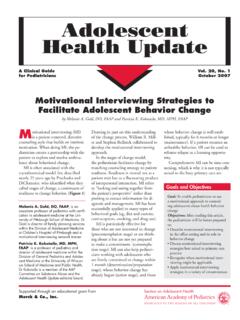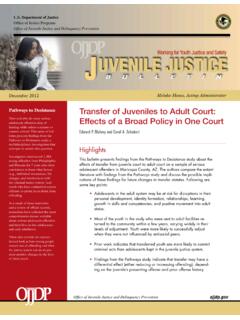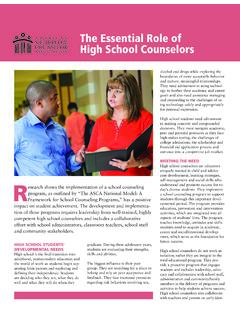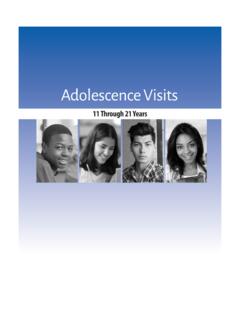Transcription of Adolescent Psychosocial, Social, and Cognitive Development
1 Article Adolescent medicine Adolescent Psychosocial, Social, and Cognitive Development Renata Arrington Sanders, Educational Gap MD, MPH, ScM. The Cognitive and psychosocial Development of adolescents is variable. Asynchrony among physical, Cognitive , and psychosocial Development may limit the adolescents' abil- Author Disclosure ity to perceive and judge risk effectively and may result in Adolescent views that are in- Dr Sanders has congruous with parents or guardians. Pediatricians can help adolescents to transition disclosed no financial through this important developmental period while simultaneously providing parents relationships relevant with appropriate guidance and support.
2 To this article. This commentary does not Objectives After completing this article, readers should be able to: contain discussion of unapproved/ 1. Understand the stages of Cognitive and psychosocial Adolescent Development . investigative use of 2. Understand the role of the imaginary audience and the personal fable in Adolescent a commercial product/ Development . device. 3. Recognize the implications of early pubertal timing. 4. Be able to communicate effectively with adolescents and address developmental concerns that may arise. Cognitive Development Adolescence marks the transition from childhood into adulthood.
3 It is characterized by Cognitive , psychosocial, and emotional Development . Cognitive Development is the pro- gression of thinking from the way a child does to the way an adult does. There are 3 main areas of Cognitive Development that occur during adolescence. First, adolescents develop more advanced reasoning skills, including the ability to explore a full range of possibilities inherent in a situation, think hypothetically (contrary-fact situations), and use a logical thought process. Second, adolescents develop the ability to think abstractly.
4 Adolescents move from be- ing concrete thinkers, who think of things that they have direct contact with or knowledge about, to abstract thinkers, who can imagine things not seen or experienced. This allows adolescents to have the capacity to love, think about spirituality, and participate in more advanced mathematics. Youth who remain at the level of a concrete thinker focus largely on physically present or real objects in problem solving and, as a result, may present with dif culty or frustration with schoolwork as they transition throughout high school.
5 Clini- cians can help parents recognize this problem to help adolescents adjust to the educational pace. Adolescents may also experience a personal fable as a result of being able to think more abstractly. The personal fable is built on the fact that if the imaginary audience (peers) is watching and thinking about the Adolescent , then the Adolescent must be special or differ- ent. For decades, this Adolescent egocentrism was thought to contribute to the personal fable of invincibility (eg, other adolescents will get pregnant or get sexually transmitted infections) and risk-taking behavior.
6 Several studies have found that adolescents perceive more risk in certain areas than adults but that being aware of the risks fails to stop adolescents from participating in risk-taking behavior. Neuroimaging studies demonstrate that adolescents may experience greater emo- tional satisfaction with risk-taking behavior. This satisfaction can predispose adolescents to engage in behavior despite being aware of risks. In addition, concrete-thinking adolescents Division of General Pediatrics & Adolescent Medicine, Johns Hopkins School of Medicine, Baltimore, MD.
7 354 Pediatrics in Review August 2013. Adolescent medicine psychosocial Development may be unable to understand the consequences of actions become less preoccupied with their bodily changes as (eg, not taking medications), may be unable to link cause they approach the end of puberty. The Adolescent 's at- and effect in regard to health behavior (eg, smoking, tention shifts from being focused on self to adopting overeating, alcohol, drugs, reckless driving, and early the codes and values of larger peer, parental, or adult sex), and may not be prepared to avoid risk (eg, having groups.)
8 Clinicians who treat adolescents can help by dis- condoms and avoiding riding with intoxicated drivers). cussing with families that this process of pubertal matu- Alternatively, youth who feel the personal fable is threat- ration will often require role readjustments among and ened can present with stress, depression, or multiple psy- between family members, which can sometimes result chosomatic symptoms. in increased stress and con ict. Third, the formal operational thinking characteristic During middle adolescence (ages 15-17 years), the of adolescence enables adolescents to think about think- peer group becomes a mixed-sex peer group and assumes ing or meta-cognition.
9 This characteristic allows youth to a primary social role for the Adolescent . Adolescents be- develop the capacity to think about what they are feeling gin to have short, intense love relationships, while and how others perceive them. This thought process, looking for the ideal partner. It is not uncommon combined with rapid emotional and physical changes that for adolescents to have crushes on adults during this occur during puberty, causes most youth to think that ev- stage. Family con ict is likely to be at its peak. As adoles- eryone is thinking not just about what they are thinking cents' independent functioning increases, adolescents about but about the youth themselves (imaginary may examine their personal experiences, relate their expe- audience).
10 Rience to others, and develop a concern for others. The imaginary audience can be detrimental to youth By late adolescence (ages 18-21 years), adolescents obtaining clinical care and services. For example, youth have developed a separate identity from parents. Simulta- with chronic illnesses may hide or deny their illnesses neously, adolescents may move away from their peer for fear that the imaginary audience (peers) may learn group and strive to achieve adult status. Adolescent con- about their condition or to prove to the audience that ict with parents may very well decline during this stage.










